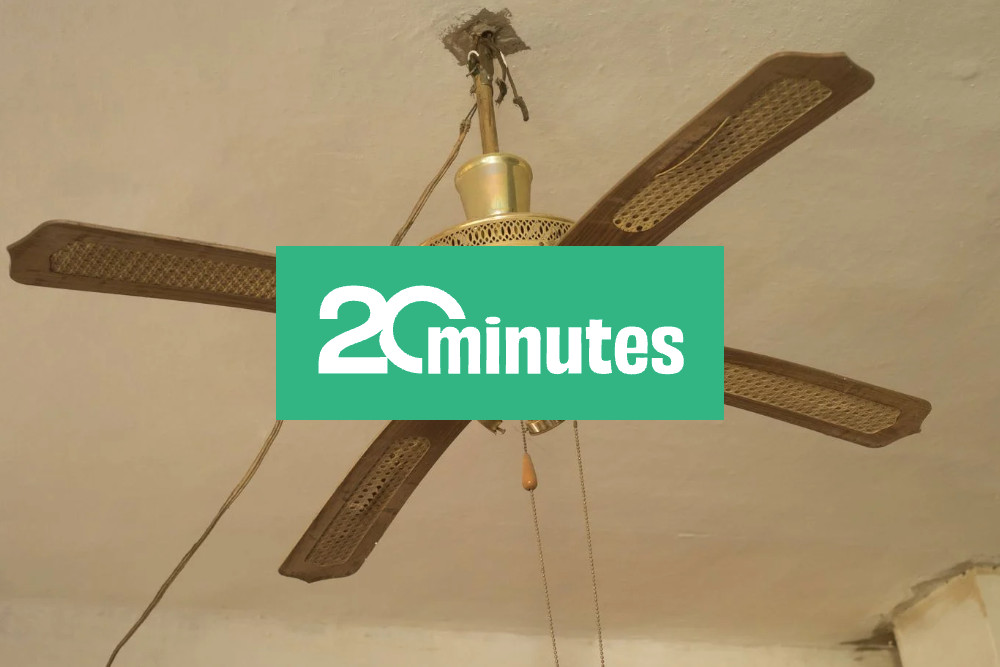Article published on 20minutes.fr – July 2, 2025
Blowing air • The ceiling-mounted fan is used in many countries and overseas territories. In mainland France, the device has long been neglected
Key points:
- In the United States and overseas territories, ceiling fans are widely used.
- In France, culturally, the device’s image remains outdated and associated with the idea of “poor man’s air conditioning.”
- However, ceiling-mounted fans, being more ecological and economical, are making a comeback, encouraged by new building standards.
Article written by Mathilde Durand
The image is a classic in cinema. A bar in Texas or a veranda in the tropics, scorching temperatures, and a fan spinning on the ceiling, with its pull chain and metal blades. A slightly kitschy vision of a device that is actually widely used in many countries around the world, especially in Southeast Asia, but also in the United States, where the usage rate exceeds 60%. In mainland France, ceiling fans are less common. Why?
“It’s very cultural,” says Patrice Wolff, director of Turbobrise and treasurer of the French Association of Ceiling Fan Professionals (AFPVP). “For some people, there’s a slightly outdated image of a low-quality fan that makes noise…” He adds: “In mainland France, we went from a situation where we had nothing, just opened the windows, to a spoiled-child situation where we jumped straight to air conditioning.” “Air conditioning was a social marker, while the fan, considered the ‘poor man’s AC,’ looked pale in comparison,” adds Claude Pichegru, manager of Guibb and secretary of the association.
An overseas solution
Has all of France turned away from ceiling fans? In the overseas territories, the reality is quite different: the usage rate ranges between 30 and 40%, according to the AFPVP. Indeed, the overseas departments are electrically non-interconnected zones, meaning they do not exchange electricity with the outside. The need to save energy is therefore even more important.
“The comeback of ceiling fans in Europe, and in France, has been largely driven by work done in the overseas departments and territories,” recalls Robert Célaire, a bioclimatic engineer, who points to the role of “air conditioning lobbies” as one of the factors behind the low adoption of ceiling fans. He is co-author of a comprehensive guide on the subject, which details, among other things, the need to integrate the ceiling fan into a building fully designed to adapt to the climate. “We are in an energy alienation situation: buildings are poorly designed, so we are forced to push the heating button in winter and the air conditioning button in summer,” he laments.
For several years, he has been working with architects to develop bioclimatic constructions, equipped notably with ceiling fans along with shutters, for example, to limit sunlight. “Many projects are set up with ceiling fans only, or in addition to air conditioning. In the new police headquarters in Cayenne, French Guiana, for example, some officers did not want air conditioning, so the offices are equipped with both systems,” he explains.
New standards
With the emergence of the concept of “summer comfort,” in response to the intensity and recurrence of heatwaves, ceiling fans are making a comeback. Their installation is encouraged by “RE 2020,” the new energy and environmental regulation that applies to all new constructions. And since December, “fixed ceiling fans” benefit from a reduced VAT rate of 5.5%.
“Things are moving, even if we are starting from far behind. We now equip many collective housing units, nursing homes, daycare centers, town halls, schools…” says Pierre Lacarrière, president of the AFPVP. “Everyone is looking for less energy-consuming solutions. The ceiling fan, alone or combined with air conditioning, can provide a solution.” Along the Mediterranean arc or on the Perpignan–Montpellier–Nice axis, ceiling fans are increasingly found on the ceilings of apartments built by property developers.
And the demand is now expanding to other areas, from Rennes to Lyon, including Île-de-France, the Southwest, and the East, enumerates the association president. Moreover, the designs are adapting: vintage-style wooden blades, connected fans, featuring LEDs… An aesthetic aspect that helps make it “a somewhat trendy tool, a cool and ecological alternative to air conditioning,” emphasizes Robert Célaire.
“People are rediscovering that riding a bike in the city instead of using a car is an obvious ecological choice. The ceiling fan is somewhat the same: it provides a service with a lower ecological, economic, and health cost, provided the building is adapted. But sometimes, it takes a long time for the obvious solution to catch on,” the engineer notes.
Read the article on 20minutes.fr
You can find the article on the 20 Minutes website: https://www.20minutes.fr/planete/rechauffement-climatique/4161496-20250702-canicule-pourquoi-plus-ventilateurs-plafond-france


